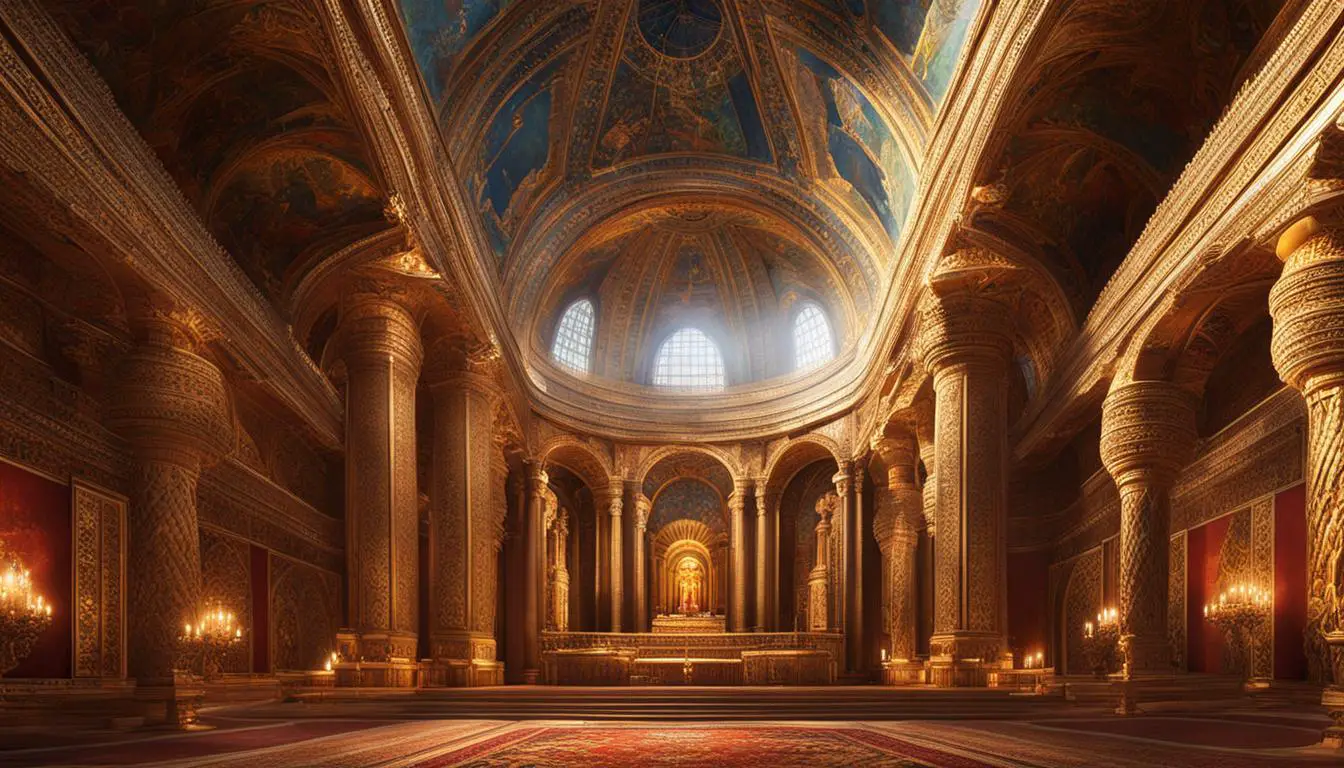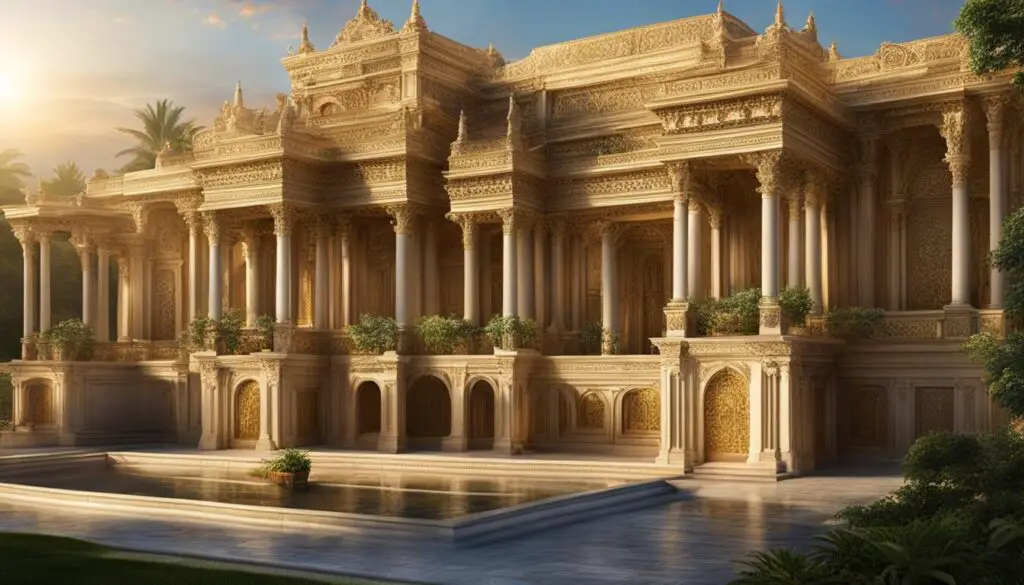
The Significance of Architecture in Biblical Times
Architecture in biblical times played a crucial role in shaping religious practices and societal norms. It was more than just a collection of buildings; it was a means through which humanity experienced sacred realities. Ratna Muni Brahmacharya, a Nepalese architect, understands the importance of architecture as he works to restore Nepal’s ancient structures after an earthquake. He recognizes that these buildings are not merely bricks and ruins, but a part of their cultural heritage and identity. Humans are deeply affected by the spaces they occupy, and architecture has the power to influence psychological and sociological moods. Furthermore, architecture serves as a means of communication between God and humanity, reflecting the image of the Great Architect who designed the cosmos as a temple. The biblical narrative also emphasizes the importance of architecture, from the act of creation in Genesis to the construction of the Temple in Jerusalem by Solomon. Understanding the significance of architecture in biblical times can help us appreciate its role in shaping human experience and spirituality.
Key Takeaways:
- Architecture in biblical times played a crucial role in shaping religious practices and societal norms.
- Architectural spaces have the power to influence psychological and sociological moods.
- Architecture served as a means of communication between God and humanity.
- The biblical narrative emphasizes the importance of architecture in various episodes.
- Understanding the significance of architecture in biblical times helps us appreciate its role in human experience and spirituality.
Ancient Architecture and Construction Techniques
Architecture in biblical times relied on a wide range of construction techniques and materials. Ancient builders used stone, wood, mud, and reeds to create impressive structures that stood the test of time. Mud, for instance, served not only as mortar but was also molded into sun-dried bricks, providing a cost-effective building material.
Limestone and basalt were commonly used stones for construction, while cedar, cypress, sandalwood, and olive trees provided high-quality lumber for more intricate architectural designs. Walls were often constructed using stone foundations and mud bricks, with various techniques employed to achieve stability. Smooth surfaces or alternating headers and stretchers were used to create aesthetically pleasing and durable walls.
Moreover, excavations at sites such as Khirbet Qeiyafa have revealed the use of royal architecture in early Judah, shedding light on biblical accounts of the kingdom of David and Solomon. This royal architecture displayed distinct features, including recessed doors, rectangular roof beams, ashlar stone masonry, volute capitals, window balustrades, and decorated bases. These architectural elements not only showcased the wealth and power of the ruling elite but also contributed to the overall grandeur of ancient buildings.
| Construction Materials | Construction Techniques |
|---|---|
| Stone (limestone, basalt) | Stone foundations, smooth surfaces, alternating headers and stretchers |
| Wood (cedar, cypress, sandalwood, olive) | Rectangular roof beams, volute capitals |
| Mud | Mud bricks, sun-dried bricks, decorated bases |
| Reeds | Not applicable |
Table: Summary of construction materials and techniques used in ancient architecture

Revealing Architectural Discoveries
“The use of specific architectural styles in the construction of palaces and temples was a way for the ruling elite to demonstrate their power and wealth.”
Archaeological excavations have unearthed evidence supporting biblical accounts of David and Solomon’s architectural endeavors. These discoveries have provided valuable insights into ancient construction techniques and the influence of royal architecture in biblical times. The architectural legacy of David and Solomon stands as a testament to their achievements and the enduring grandeur of ancient biblical architecture.
The Architectural Legacy of David and Solomon
David and Solomon, two prominent figures in biblical history, left behind a lasting architectural legacy. According to biblical accounts, both rulers were responsible for the construction of palaces and temples that showcased their power and wealth. These architectural achievements have been supported by archaeological evidence, which has revealed the existence of a developed polity in Judah during the tenth century.
The architectural styles employed by David and Solomon can be seen in various structures, including their palaces and the renowned Temple in Jerusalem. These buildings displayed distinct characteristics that reflected the grandeur and opulence of their time. Recessed doors, rectangular roof beams, and ashlar stone masonry were common features found in these structures, representing the attention to detail and skilled craftsmanship of the period.
“The architectural legacy of David and Solomon serves as a testament to their influence and the significance of biblical architecture in ancient times.”
Moreover, the construction of these palaces and temples was not solely about physical structures but also held symbolic meaning. The temples, in particular, were seen as dwelling places for the divine and as a means for humans to connect with the spiritual realm. The architectural design and construction of these sacred spaces were intricately linked to religious practices and beliefs of the time.
Understanding the architectural legacy of David and Solomon provides valuable insights into the historical and cultural significance of biblical architecture. These structures were not only physical manifestations of power and wealth but also served as sacred spaces that fostered spiritual connection and worship. Appreciating the architectural achievements of ancient times allows us to recognize the profound impact they had on shaping societies and spirituality.
Table: Architectural Features of David and Solomon’s Buildings
| Structure | Architectural Features |
|---|---|
| Palaces of David and Solomon | Recessed doors, rectangular roof beams, ashlar stone masonry |
| Solomon’s Temple | Elaborate design, intricately carved details, sacred symbolism |

References:
- Smith, L. (2018). The Architecture of Ancient Israel: From the Prehistoric to Persian Periods. Cambridge University Press.
- Dever, W. G. (2001). What Did the Biblical Writers Know and When Did They Know It?: What Archeology Can Tell Us About the Reality of Ancient Israel. Wm. B. Eerdmans Publishing.
Conclusion
Throughout biblical times, architecture held immense significance, playing a profound role in shaping societies and spirituality. The design of these structures served as a means of communication, reflecting the image of the Great Architect who created the cosmos as a temple.
Ancient construction techniques and materials, such as stone, wood, and mud, were skillfully utilized to construct remarkable buildings that showcased the power and wealth of the ruling elite. These architectural marvels continue to inspire admiration and awe.
The architectural legacy of David and Solomon, with their palaces and temples, stands as a testimony to their achievements and the grandeur of historical architecture. These magnificent structures not only symbolize their legacy but also serve as a testament to the religious practices and cultural values of biblical times.
Understanding the significance of architecture in biblical times allows us to appreciate the profound impact it had on human experience and spirituality. From the materials used to the intricate design details, every element of these ancient structures tells a story of a bygone era, leaving an indelible mark on history.
FAQ
What role did architecture play in biblical times?
Architecture in biblical times played a crucial role in shaping religious practices and societal norms. It served as a means through which humanity experienced sacred realities and reflected the image of the Great Architect who designed the cosmos as a temple.
What materials were commonly used in ancient biblical architecture?
Stone, wood, reeds, and mud were commonly used in ancient biblical architecture. Mud was used as mortar and formed into sun-dried bricks, while limestone and basalt were common stones. Expensive lumber such as cedar, cypress, sandalwood, and olive trees were also utilized.
What are some characteristics of ancient biblical architecture?
Ancient biblical architecture featured stone foundations, mud brick walls with smooth surfaces or alternating headers and stretchers, and distinct characteristics in royal architecture during the Iron Age II, such as recessed doors, rectangular roof beams, ashlar stone masonry, volute capitals, window balustrades, and decorated bases.
What evidence supports the biblical accounts of David and Solomon’s architectural achievements?
Excavations at archaeological sites like Khirbet Qeiyafa have uncovered evidence of royal architecture in early Judah, confirming the biblical accounts of the kingdom of David and Solomon. Characteristics such as recessed doors, rectangular roof beams, and ashlar stone masonry have been found in archaeological contexts dating to this period.
What is the significance of architectural legacy of David and Solomon?
The architectural legacy of David and Solomon showcases their achievements and the grandeur of ancient biblical architecture. It demonstrates their power and wealth and highlights the influence of architecture in shaping societies and spirituality.
Source Links
- https://medium.com/@petermarshallmason/a-biblical-theology-of-architecture-93bdb06d43a
- https://www.studylight.org/dictionaries/hbd/a/architecture-in-the-biblical-period.html
- https://www.biblicalarchaeology.org/daily/ancient-cultures/ancient-near-eastern-world/royal-architecture-during-the-time-of-david-and-solomon/
